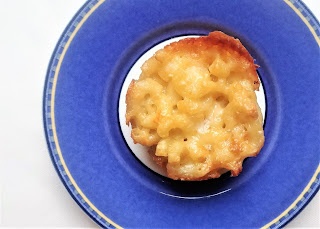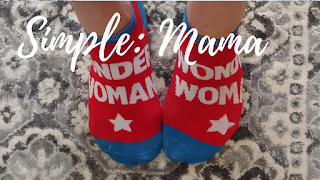Bread and Wine: Mini Mac and Cheese
Oh, I don't know...
MINI MAC AND CHEESE.
Good grief, these things are goooooood. Totally worth every, single, butterfat-and-starch-filled bite.
In fact, I think I'm going to unofficially title this blog: "Why Butterfat and Starch are Very, Very Important."
Because they are.
The recipe comes in the chapter "What the Table is For," in Bread and Wine, and this is one of my favorites. Niequist writes this lovely, luxurious reminiscence of her and her husband's supper club, how they've been meeting monthly (more or less) for three years, and how they've created this tightly woven community around the mere act and place of table.
But what I think I like most about this chapter is how Niequist establishes the iconic nature of food and its ability to embody grace, mercy, and compassion--the things of God--and be shared with others in a tangible way.
First, let's chat about this recipe and how impossibly good it is, and then I'll circle back around to icons.
I don't know about you, but macaroni and cheese was a pretty essential staple in my childhood--the ultimate comfort food. My mom made hers without a mix, boiling the white macaroni, melting pat upon pat of butter and warm milk over the noodles in the saucepan and then layering on the sheets and sheets of Kraft American Cheese. She'd salt it a little, stir, stir, taste, add a little more milk, a little more butter, another slice of cheese, eat a slice of cheese, and stir, stir, some more.
When dinner was ready she poured the noodles and sauce into a creamy mound next to the meatloaf or vegetables we were also having and we'd eat everything with a little bit of macaroni and cheese on the fork. It was even part of our weekly "vegetable plate" supper, because we live in the South, and macaroni and cheese is totally a vegetable here. The Cracker Barrell menu says so.
Fast forward to when I moved out and started cooking on my own. I had gone all health-nutty and clean food during my years of dance in high-school and college, so by the time I graduated I finally understood that Kraft American cheese isn't really "cheese" (sorry if I'm breaking the news!) so much as an oil and milk and diglycerides concoction, kind of like Crisco. I realized my body didn't like fake cheese (even if my taste buds did) so I had to figure out another way to make macaroni and cheese if I was going to in fact still eat it.
Oh, I was going to find a way.
If you've never tried to make non-mix, natural macaroni and cheese, you can be in for a bit of a shock. Most of the cheeses in the grocery dairy cooler don't melt easily and often clump up in the noodles, resulting in an oily lumpage that's anything but appetizing. After a lot of experimenting in which I discovered that I actually hate a lot of natural macaroni and cheese dishes (most of which are baked and have too much egg in them for my taste), I settled back into the fat. I thought more along the lines of fondue and so got comfortable with using lots of butter, lots of milk, and letting the warmed cheese (I like Colby Jack) slowly coat the noodles. It even works on whole-wheat pasta--just a little more fat, a little more time. Stir, stir.
Even my husband, raised on boxed macaroni and cheese, loves it.
So when I came to this recipe, I was suspicious. It's BAKED. It has EGG in it. And...Parmesan cheese?
I'm sorry, but I need melty and gooey, not egged-up and stiff, no matter how much cheese is packed in there.
So there's my baggage that I brought to this recipe. Doubtful, but hopeful, I started.
The recipe calls for grated Parmesan cheese (and I assumed Niequist didn't intend the little green shaker can I grew up using over my spaghetti), so I got my wedge and started grating away, only to realize quickly that it didn't need to be shredded as much as truly grated into little granules. You're supposed to dust your muffin pans with it, so yeah, you need the dust. I tried again. Success.
There, the pans look pretty--all buttered and Parmesan-dusted up.
The sauce for the noodles is dreamy-- I'm not sure what makes it different than others I've made, but the egg didn't take center stage like it does in many other sauces. Maybe it's the "two dashes" of Tabasco sauce (and here I'm going to admit that I'm a Southerner and I've NEVER made anything with Tobasco sauce. EVAH. But I have now, so it's okay). The recipe calls for "two shakes" and I wasn't sure if my two shakes were enough. I did a few more to make sure. It was fine.
But actually let's talk about DIJON.
Niequist uses a few probably-not-already-in-your-pantry ingredients in Bread and Wine and Dijon mustard was one for me. I had never used it, but now I'm all like, DOES IT COME IN MULTI- PACKS? Because this stuff is good. Seriously good. It's the missing link to my Christmas ham. My salad dressings have come alive. And this baked macaroni tasted amaze-balls. The reason? At least in part, Dijon mustard.
I'm getting all drooly thinking about it.
So I took this gooey batch of sauce and poured in the noodles and freaked a teeny tiny bit because the sauce was getting stringy and there's no way that all of this will neatly land in these pretty little muffin pans and bake into something I and my family actually want to eat. But it did, and whoa-ho-ho we did.
The recipe calls for mini-muffin pans to be used so the mini mac and cheese can be served as appetizers at your next party. That's fine, except I'm not sure I want to serve these at a party because I wouldn't talk to anyone; I'd just stand in a corner stuffing my mouth. I made mine in regular-sized muffin tins with the idea that I'd serve them next to salad for an actual meal.
It was a hit.. "Oh, that's so much happiness in there!" my husband wept (not really, but almost). "They're next to Cameron's wings!" (Cameron is my brother in law who makes amazing hot wings, so this is very high praise).
My daughter ate enthusiastically, chirping, "I like this! I like this!" I mean, really, it's not a hard sell-- soft, buttery pasta tucked inside a light cheese crust, basically. What kid will turn this down?
Personally I was a little aghast at how oily they were-- these things are rich. I made a mental note to tone down my butter usage when prepping the pans--maybe not use a brush/baster as much as a light, quick wipe with a buttered paper towel. I mean, I'm not really one to hold back on butterfat as long as it's all natural, but texture does become a bit of an issue when oil is running on to your fingers. Not that that's an incredibly bad thing, but if wer're going to nitpick....
Since we like spicy food, I topped ours with crumbled bacon and roasted jalapenos, and my mind went all crazy with the possibilities for toppings: Fried chicken nuggets? A hunk of Gouda or Havarti? Fried jalapeno chips? Roasted peppers?
My imagination and cholesterol soared with the possibilities....
Now to talk a little about icons.
While reading this chapter I meditated on Niequist's description on the importance of table to her supper group--its uniting effect, its comforting, life-raft quality to bring establishment to a group very much in transition. The flavors, like Mini-Mac and Cheese--shared around that table fed memories, and the memories the flavors until each recipe presented becomes more than merely directions for making food, but rather a beam for upholding community, relationships.
My mind ran to the idea of icons. The idea that a physical something can embody more than its parts.
Madeleine L'Engle, in her devotional Walking on Water, describes something "iconic" like this:
"An icon is a symbol, rather than a sign. A sign may point the way to something, such as: Athens--10 kilometers. But the sign is not Athens, even when we reach the city limits and Athens. A symbol, however, is unlike a sign, and contains within it some quality of what it represents."
She then goes on to ascribe iconic qualities to people whom she calls "living mysteries". She quotes Emmanuel, Cardinal Suhard:
"To be a witness does not consist in engaging in propaganda, nor even in stirring people up, but in being a living mystery. It means to live in such a way that one's life would not make sense if God did not exist."
To live... to work... to paint... to write... to cook... in such a way.
This seems to me what "icon" or "iconic" means-- God being in all and through it all, giving each physical thing meaning and purpose.
This seems to me what "icon" or "iconic" means-- God being in all and through it all, giving each physical thing meaning and purpose.
This is why these delicious little bites can take on meaning. Because it's not ultimately about the butterfat and starch, though those things are very nice. They, just like any food, can become offerings of encouragement and nourishment, grace incarnated in a little serving on a plate.
Niequist hints at this mystery as it is embodied in their supper club; how their relationships have formed in a way over food and table that really none of them could have exactly made happen. Like faith. Like mystery:
"You don't always know what's going to come of it, but you put the time in anyway, and then, after a long, long time, you realize with great clarity why you put the time in: for this one night, for these hours around the table, for the complexity and richness of flavors that are so lovely and unexpected you're still thinking about them the next day."
She goes on to say, ""That's how I am today, still kind of mesmerized by last night […] feeling like this is what life is for, this is what Sunday nights are for, this is what the table is for."
For people. For love. Always, always love.








Comments
Post a Comment